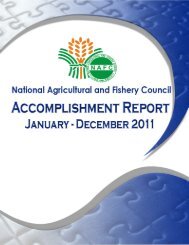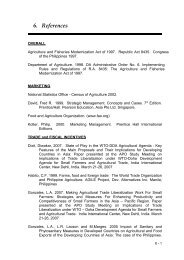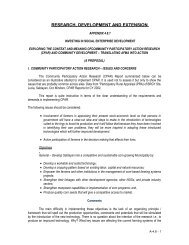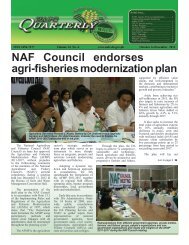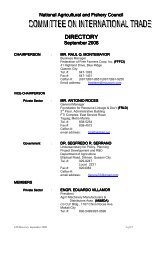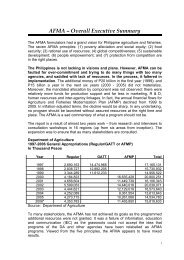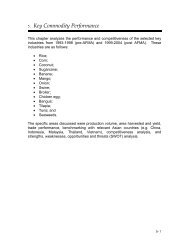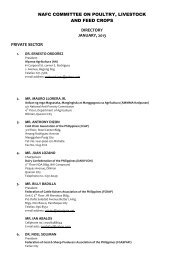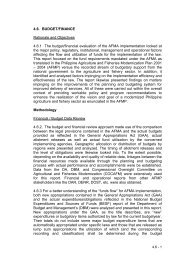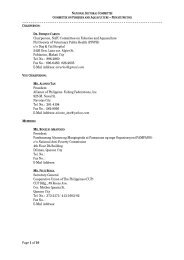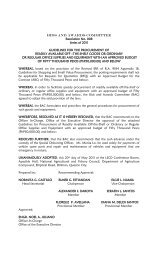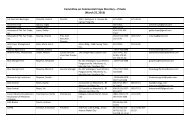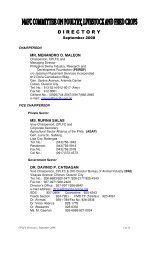Trade and Fiscal Incentives - National Agricultural and Fishery ...
Trade and Fiscal Incentives - National Agricultural and Fishery ...
Trade and Fiscal Incentives - National Agricultural and Fishery ...
Create successful ePaper yourself
Turn your PDF publications into a flip-book with our unique Google optimized e-Paper software.
4.2.51 The above results from respondents’ perceptions on ACEF, are reflective<br />
of the general state of affairs of the ACEF credit facility. The fact that around PhP<br />
2.7 billion are still unallocated, implies that the system of ACEF project loan<br />
processing is flawed <strong>and</strong> has not really supported the agricultural modernization<br />
efforts in the countryside.<br />
Impact of AFMA <strong>Trade</strong> Component on Agriculture <strong>and</strong> Fisheries<br />
4.2.52 The Regional consultations / workshops across the 16 Regions took two<br />
days each. The workshops were focused on the general impact of AFMA<br />
components (irrigation, postharvest, other infrastructures, credit, trade,<br />
marketing, information, support, st<strong>and</strong>ardization <strong>and</strong> consumer safety, education,<br />
research <strong>and</strong> development, <strong>and</strong> extension) taken as whole on at least five (5)<br />
commodity groupings (rice, corn, (grains), high value commercial crops, livestock<br />
<strong>and</strong> poultry, <strong>and</strong> fisheries). The AFMA impact assessment at the Regional level<br />
covered discussions on general <strong>and</strong> qualitative impact, budget adequacy <strong>and</strong><br />
prioritization, assessment of level of implementation, priority issues <strong>and</strong><br />
concerns, priority focus of interventions, <strong>and</strong> proposals for improvement. The<br />
succeeding discussions highlight the general assessment of the impact of trade<br />
as a component of AFMA, on the five commodity groupings.<br />
a. <strong>Trade</strong> <strong>and</strong> the Rice Subsector<br />
4.2.53 The general impact of trade as a component of AFMA, reasons for impact,<br />
<strong>and</strong> qualitative level of implementation, <strong>and</strong> proposals for improvement of trade<br />
in the rice subsector are summarized in Table 4.2.16. Of the ten (10) Regions<br />
that discussed the general impact of trade as a component of AFMA on the rice<br />
subsector four (4) Regions (40%) indicated that trade component (including fiscal<br />
incentives in terms of tariff free inputs of agricultural inputs) had no impact on the<br />
rice subsector. The remaining 6 (60%) of the ten (10) Regions affirmed that trade<br />
had low (1 to 3, on a scale of 10, 8 to 10 being high) impact on rice agribusiness<br />
systems.<br />
4.2.54 The major reasons cited for the no impact of trade on rice include: rice is<br />
not competitive, high costs of fertilizer, rice smuggling (Region 2), no specific<br />
program to address trade (Region 8), weak program (Region 10), untimely<br />
importations <strong>and</strong> high costs of inputs (Region 11). On the other h<strong>and</strong>, the major<br />
reasons cited for low impact of trade on the rice subsector were: rice importation<br />
<strong>and</strong> its untimeliness have negative effect on rice production (Regions 4-B, 4-A,<br />
11, <strong>and</strong> 12); high costs of inputs <strong>and</strong> limited availment of imported fertilizer<br />
(Regions 9, 11, 12, <strong>and</strong> CARAGA); lack of information <strong>and</strong> awareness (Region<br />
3); <strong>and</strong> guidelines of the rice program not properly implemented (CARAGA).<br />
4.2 - 30



